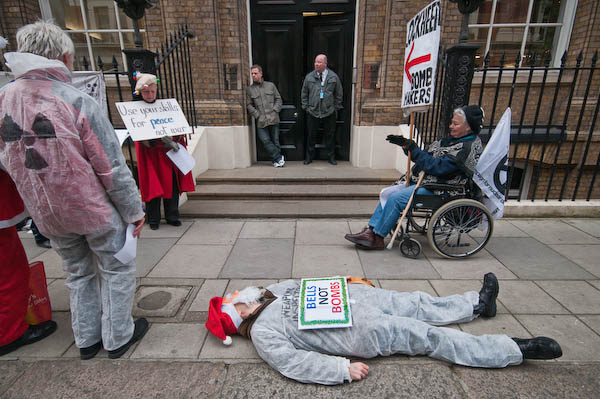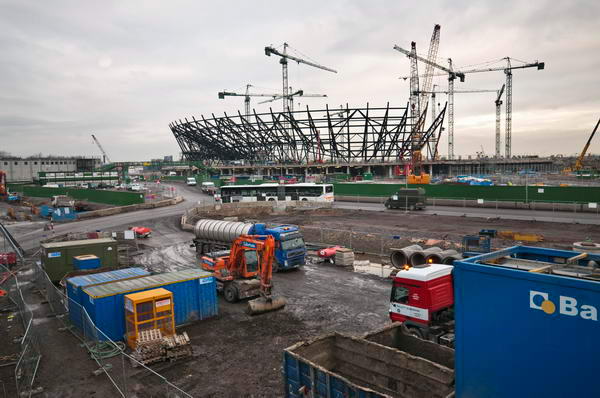Serenading the Bomb Makers: Given the current increased tension over the possible nuclear escalation of the Ukraine war – something that would be disastrous to us all and totally insane and irrational, but if NATO keep poking the Russian Bear with a stick could be provoked – it seems appropriate to remember the lunchtime tour around the London offices of some of the companies involved in making the UK’s nuclear weapons on Friday 12th December 2008.
I don’t think I can improve on the piece I posted on My London Diary in 2008 – except by adding the odd word that somehow got missed out, so I’ll copy that here, with some of the pictures from the event. I got too cold standing around and left after an hour and went to take a short look at the work taking place on the Olympic site at Stratford Marsh as the light was beginning to fade.
‘Muriel Lesters’ Serenade the Bomb Makers

Ten activists turned up in Victoria, London on Friday for a festive protest outside the offices of the US company behind the production of the UK’s nuclear weapons and the huge expansion of bomb production facilities at Aldermaston – costing £6,000,000,000 – which has never been debated or approved by Parliament.
They were the ‘Muriel Lesters*’, a London affinity group of Trident Ploughshares. Dressed in Santa suits, white nuclear inspector overalls and festive hats they called for an end to bomb production at the Atomic Weapons Establishment (AWE).

Appropriately, their renditions of festive songs and carols with modified anti-nuclear lyrics were largely less than tuneful (one taking part was hear to say “I’m a Quaker, we don’t sing” and who could contradict him?) They called for a stop to the illegal activities of these companies in making weapons.
First to be serenaded by the group were the offices of the US arms giant Lockheed Martin, makers of ‘bunker buster’ and ‘cluster’ bombs, the worlds largest exporter of weapons and the leading member of the consortium set up to produce the nuclear warheads for the UK Trident replacement at Aldermaston.

After an hour or so of leafleting and displaying banners on Vauxhall Bridge Road just around the corner, the group moved to the front door of the building housing Lockheed Martin and several other companies in Carlisle Place for their half hour carol ‘concert’. It was a site I knew from the ‘Merchants of Death‘ tour by CAAT earlier in the year. A number of people came in an out of the building while this was going on and some took leaflets while others hurried past, often to waiting taxis.
Half way through the performance, a police car pulled up and dropped off two constables who came to talk to the protesters. They asked who was in charge (and of course nobody was) and for a mobile number they could use to contact the group, saying “it’s standard practice for protests“. Oh no it isn’t! They were handed a leaflet with the Norwich details of Trident Ploughshares, but that wasn’t what they had in mind.

The police were informed that the real criminals were in the Lockheed Martin offices, carrying out the vast expansion in UK nuclear arms, a breach of the UK’s obligations under Article VI of the Nuclear Non-Proliferation Treaty, and that they were involved in an illegal conspiracy with some groups we could name down the road in Whitehall. The police chose to ignore this vital evidence but eventually they went away, reminding the protesters that while they supported the right to demonstrate, it was important to keep the pavement clear.
As they left, one member of the group stretched out “dead” on his back on that pavement as a symbol of the many victims of nuclear weapons, including those killed in nuclear strikes on Hiroshima and Nagasaki, “bomb test veterans, and victims of leukaemias, lymphomas and cancers caused by exposure to radioactive discharges from AWE Aldermaston and AWE Burghfield in Berkshire, Sellafield in Cumbria, Rolls Royce Raynesway in Derby and other sites“

I left the group as it packed up and decided to take a short break before going on for a similar protest at the London offices of Jacobs Engineering and Fluor Corporation, two other US companies who are competing for the stake in the AWE bomb-making contract currently filled by the British Nuclear Group. The third player in the contract – the only remaining UK involvement – is SERCO.
- Muriel Lester, (1883–1968), born in Leytonstone, was a leading Christian peace campaigner and writer. Among many other things she founded Kingsley Hall in Bow, was a friend of Gandhi, Travelling Secretary of the International Fellowship of Reconciliation and was detained for ten weeks in Trinidad and then several days in Holloway Prison for her activities during the Second World War.
Olympic Site – Stratford

A few more pictures from around the London 2012 site.
Flickr – Facebook – My London Diary – Hull Photos – Lea Valley – Paris
London’s Industrial Heritage – London Photos
All photographs on this page are copyright © Peter Marshall.
Contact me to buy prints or licence to reproduce.














